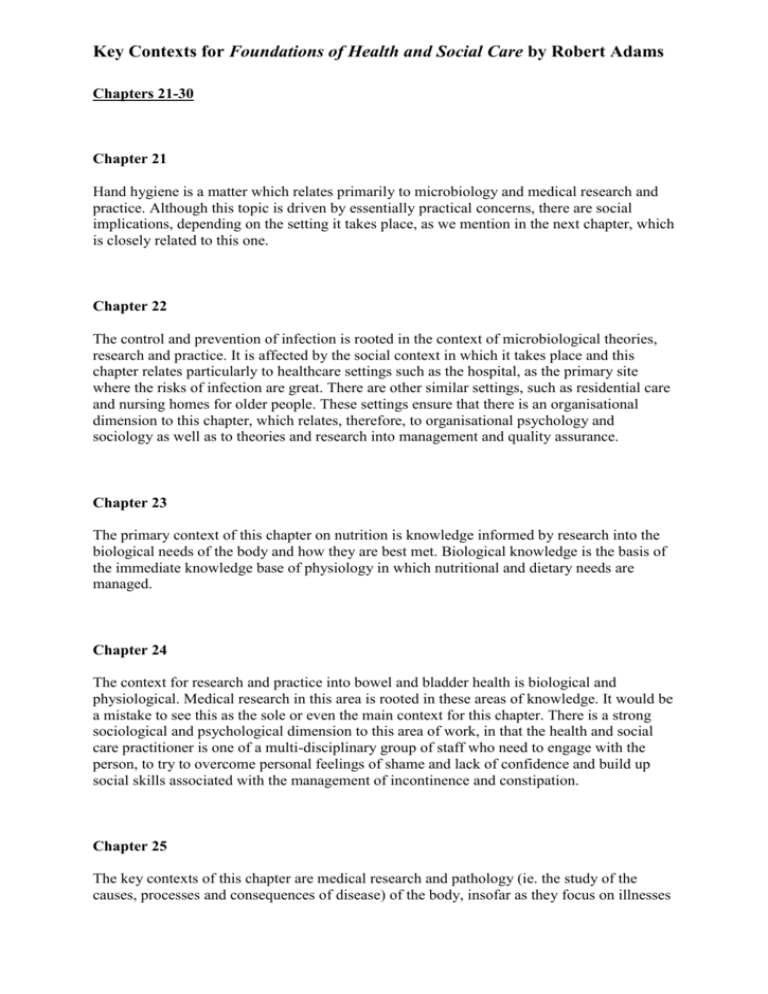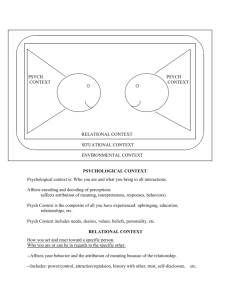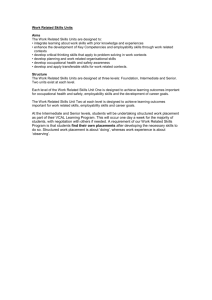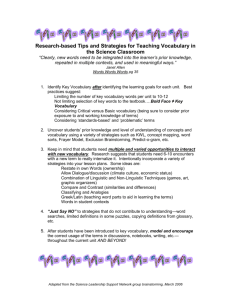Key Contexts Chapters 21-30 Word Document
advertisement

Key Contexts for Foundations of Health and Social Care by Robert Adams Chapters 21-30 Chapter 21 Hand hygiene is a matter which relates primarily to microbiology and medical research and practice. Although this topic is driven by essentially practical concerns, there are social implications, depending on the setting it takes place, as we mention in the next chapter, which is closely related to this one. Chapter 22 The control and prevention of infection is rooted in the context of microbiological theories, research and practice. It is affected by the social context in which it takes place and this chapter relates particularly to healthcare settings such as the hospital, as the primary site where the risks of infection are great. There are other similar settings, such as residential care and nursing homes for older people. These settings ensure that there is an organisational dimension to this chapter, which relates, therefore, to organisational psychology and sociology as well as to theories and research into management and quality assurance. Chapter 23 The primary context of this chapter on nutrition is knowledge informed by research into the biological needs of the body and how they are best met. Biological knowledge is the basis of the immediate knowledge base of physiology in which nutritional and dietary needs are managed. Chapter 24 The context for research and practice into bowel and bladder health is biological and physiological. Medical research in this area is rooted in these areas of knowledge. It would be a mistake to see this as the sole or even the main context for this chapter. There is a strong sociological and psychological dimension to this area of work, in that the health and social care practitioner is one of a multi-disciplinary group of staff who need to engage with the person, to try to overcome personal feelings of shame and lack of confidence and build up social skills associated with the management of incontinence and constipation. Chapter 25 The key contexts of this chapter are medical research and pathology (ie. the study of the causes, processes and consequences of disease) of the body, insofar as they focus on illnesses Key Contexts for Foundations of Health and Social Care by Robert Adams and conditions. The chapter takes a very general approach, focusing attention briefly on a few of the main illnesses and conditions the basic health and social care practitioner is likely to encounter. Chapter 26 The study of pain is not straightforward. As the definition of pain in the chapter indicates, pain itself is somewhat problematic as a concept, because there is no necessary physical proof of what a person experiences. Pain, therefore, is what you say you feel, rather than what you feel, that can be corroborated independently by a physical test. So we have to say that the major contexts for this chapter should be both the physical pathology and the psychopathology (psychology of disease) of pain. Pain could have mental as well as physical origins. We have started with the more complicated and difficult to grasp context for pain. The most obvious and immediately accessible one is based in the physical diseases and conditions which produce immediately obvious and verifiable signs – such as swellings over a broken bone – the origins of which lie in the anatomy and physiology of the body. Chapter 27 The key contexts for this chapter are biological, specifically in the physiology of the human body and the medical research which has enabled the practice of wound management to make advances. Chapter 28 This chapter is located in the largely medical and biological context of the process of dying and the psychological context of theories, research and practice concerning bereavement processes. Dying is more than a physical process located in medical practice, of course. It is a complex social and psychological event, usually associated with a variety of often major and traumatic psychological and spiritual consequences for relatives and friends. Sometimes the death is so traumatic that medical and health and social care staff are affected. The process of bereavement has a social dimension, in that funerals and mourning in many ethnic groups, cultures and faith communities are associated with prolonged rituals of transition and have an anthropological dimension. Part IV This deals with the process of practice. It discusses the idea of process in Chapter 29 and the following four chapters go through the stages of the work. Key Contexts for Foundations of Health and Social Care by Robert Adams Chapter 29 This chapter relates to frameworks of ideas about processes in health/nursing and social care/social work. Most of the literature on the health side is rooted in nursing and midwifery, whilst that on the social care side is drawn from social work. The similarities between the nursing and social work processes are far greater than the differences. The differences are mainly in emphasis, reflected in the slightly different language used as headings for the four stages. Chapter 30 The main contexts for this chapter on assessment are the social sciences which inform the assessment process. Chiefly, these are psychological and sociological, with some social policy perspectives having relevance. These disciplines enable the practitioner to draw on knowledge of the problems which afflict a particular vulnerable person at their stage in the life course, in their geographical locality, given their ethnic, gender and cultural and religious background, and contribute to the local environmental and family factors which interact with their personal history and development and lead them to express the wants and needs they have today.









